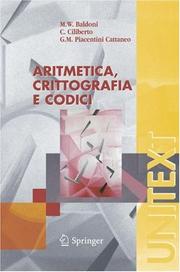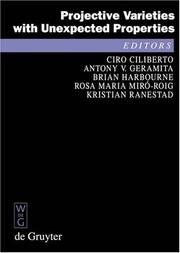| Listing 1 - 4 of 4 |
Sort by
|
Book
ISBN: 1281344990 9786611344993 8847007143 8847007135 Year: 2008 Publisher: Milano : Springer,
Abstract | Keywords | Export | Availability | Bookmark
 Loading...
Loading...Choose an application
- Reference Manager
- EndNote
- RefWorks (Direct export to RefWorks)
Questo libro è una galleria estremamente variegata di ironiche riflessioni sul mondo accademico, di lievi aneddoti, di pacate provocazioni, di appunti di viaggi, di ritratti di matematici famosi, sospesi tra scherzo e serietà, tra sogno e realtà. Aprono la raccolta due squisite fantasie di Arthur Porges e Arthur Koestler, seguite da racconti scritti da matematici di professione, che hanno per hobby la letteratura, ispirati a personaggi e fatti, a emozioni e fantasie legati al mondo della matematica. Docenti, ricercatori e studenti di matematica potranno riconoscere, con gusto e partecipazione, situazioni loro familiari. Ma anche chi matematico non è potrà godersi questa piacevole lettura, trovando magari stimoli a guardare più da vicino questo universo popolato da numeri, forme, idee e assaporando le gioie, i dolori, l'umorismo, l'armonia e perfino la magia nascosta in una disciplina che, seppur complicata, è ricca di calore e sentimento.
Mathematics --- Short stories, Italian. --- Italian short stories --- Italian fiction --- Science (General). --- Mathematics. --- Popular Science, general. --- Mathematics, general. --- Math --- Science --- Popular works.

ISBN: 884700456X 8847004551 Year: 2006 Publisher: Milano : Springer Milan : Imprint: Springer,
Abstract | Keywords | Export | Availability | Bookmark
 Loading...
Loading...Choose an application
- Reference Manager
- EndNote
- RefWorks (Direct export to RefWorks)
Si sviluppano le tecniche di base di algebra e di teoria dei numeri utili in recenti applicazioni alla crittografia e ai codici, con l’intento di essere elementari e autosufficienti. Viene posto l’accento su problemi di natura computazionale. Questa parte del volume può essere utile quale libro di testo per un primo corso di algebra per matematici, informatici o ignegneri. Vengono poi illustrate importanti applicazioni dell’algebra e della geometria alla crittografia e ai codici. Entrambi, crittografia e codici hanno notevoli applicazioni nella vita quotidiana che vengono qui illustrate. La crittografia è sviluppata in dettaglio in gran parte dei suoi aspetti classici e attuali, e viene sviluppata sia la crittografia a chiave privata che quella a chiave pubblica. Viene anche illustrata la crittografia con l’uso di curve ellittiche sui campi finiti. Ai codici lineari è dedicato un capitolo di introduzione all’argomento. Questa parte del libro può essere utile per un corso della laurea triennale o specialistica per matematici, fisici, informatici o ingegneri. Il libro è ricco di complementi ed esercizi, in buona parte svolti. Vengono indicate le parti e gli esercizi di maggiore o minore difficoltà. .
Cryptography --- Number theory --- Coding theory. --- Mathematics. --- Math --- Science --- Data compression (Telecommunication) --- Digital electronics --- Information theory --- Machine theory --- Signal theory (Telecommunication) --- Computer programming --- Number study --- Numbers, Theory of --- Algebra --- Cryptanalysis --- Cryptology --- Secret writing --- Steganography --- Signs and symbols --- Symbolism --- Writing --- Ciphers --- Data encryption (Computer science) --- Combinatorics. --- Geometry. --- Number theory. --- Algebra. --- Number Theory. --- Mathematics --- Mathematical analysis --- Euclid's Elements --- Combinatorics
Book
ISBN: 3540691995 3540692002 Year: 2009 Publisher: Berlin, Heidelberg : Springer Berlin Heidelberg : Imprint: Springer,
Abstract | Keywords | Export | Availability | Bookmark
 Loading...
Loading...Choose an application
- Reference Manager
- EndNote
- RefWorks (Direct export to RefWorks)
In this volume one finds basic techniques from algebra and number theory (e.g. congruences, unique factorization domains, finite fields, quadratic residues, primality tests, continued fractions, etc.) which in recent years have proven to be extremely useful for applications to cryptography and coding theory. Both cryptography and codes have crucial applications in our daily lives, and they are described here, while the complexity problems that arise in implementing the related numerical algorithms are also taken into due account. Cryptography has been developed in great detail, both in its classical and more recent aspects. In particular public key cryptography is extensively discussed, the use of algebraic geometry, specifically of elliptic curves over finite fields, is illustrated, and a final chapter is devoted to quantum cryptography, which is the new frontier of the field. Coding theory is not discussed in full; however a chapter, sufficient for a good introduction to the subject, has been devoted to linear codes. Each chapter ends with several complements and with an extensive list of exercises, the solutions to most of which are included in the last chapter. Though the book contains advanced material, such as cryptography on elliptic curves, Goppa codes using algebraic curves over finite fields, and the recent AKS polynomial primality test, the authors' objective has been to keep the exposition as self-contained and elementary as possible. Therefore the book will be useful to students and researchers, both in theoretical (e.g. mathematicians) and in applied sciences (e.g. physicists, engineers, computer scientists, etc.) seeking a friendly introduction to the important subjects treated here. The book will also be useful for teachers who intend to give courses on these topics.
Cryptography. --- Electronic books. -- local. --- Number theory. --- Number theory --- Cryptography --- Coding theory --- Ciphers --- Algebra --- Mathematics --- Physical Sciences & Mathematics --- Cryptanalysis --- Cryptology --- Secret writing --- Steganography --- Number study --- Numbers, Theory of --- Mathematics. --- Data structures (Computer science). --- Algebra. --- Geometry. --- Combinatorics. --- Number Theory. --- Data Structures, Cryptology and Information Theory. --- Combinatorics --- Mathematical analysis --- Euclid's Elements --- Information structures (Computer science) --- Structures, Data (Computer science) --- Structures, Information (Computer science) --- Electronic data processing --- File organization (Computer science) --- Abstract data types (Computer science) --- Math --- Science --- Signs and symbols --- Symbolism --- Writing --- Data encryption (Computer science) --- Data structures (Computer scienc. --- Data Structures and Information Theory.


ISBN: 1282194828 9786612194825 311019970X 9783110199703 9783110181609 3110181606 3110181606 Year: 2008 Publisher: Berlin Boston
Abstract | Keywords | Export | Availability | Bookmark
 Loading...
Loading...Choose an application
- Reference Manager
- EndNote
- RefWorks (Direct export to RefWorks)
This volume contains refereed papers related to the lectures and talks given at a conference held in Siena (Italy) in June 2004. Also included are research papers that grew out of discussions among the participants and their collaborators. All the papers are research papers, but some of them also contain expository sections which aim to update the state of the art on the classical subject of special projective varieties and their applications and new trends like phylogenetic algebraic geometry. The topic of secant varieties and the classification of defective varieties is central and ubiquitous
Algebraic varieties --- Geometry, Projective --- Projective geometry --- Geometry, Modern --- Varieties, Algebraic --- Geometry, Algebraic --- Linear algebraic groups --- 1. ALGEBRAIC VARIETIES. 2. GEOMETRY, PROJECTIVE. --- Science
| Listing 1 - 4 of 4 |
Sort by
|

 Search
Search Feedback
Feedback About UniCat
About UniCat  Help
Help News
News